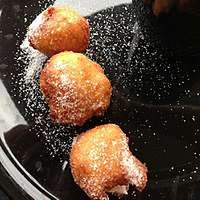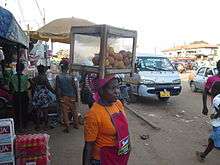Puff-puff
Puff-puff (as it is called in Nigeria and Sierra Leone, and in anglophone Cameroon; also called buffloaf [boflot] in Ghana, bofloto in the Ivory Coast, mikate in Congo, beignet in Francophone Cameroon, ligemat in Sudan and kala in Liberia) is a traditional African snack made of fried dough. The prominence of this delicacy stretches even to the eastern and southern edges of West Africa, where it is mostly known as mandazi.[1]
 | |
| Alternative names | Boflot, kala, mikate, togbei |
|---|---|
| Type | Doughnut |
| Course | snack, breakfast |
| Place of origin | Sub-Saharan Africa |
| Main ingredients | Flour, yeast, sugar, salt, butter, water, eggs, vegetable oil |
| Variations | Eggs and butter are optional |
Puff-puffs are made of dough containing flour, yeast, sugar, butter, salt, water and eggs (which are optional), and deep fried in vegetable oil to a golden brown color. Baking powder can be used in place of yeast, but yeast is more common. After frying, puff puffs can be rolled in sugar. Like the French beignet and the Italian zeppole, puff-puffs can be rolled in any spices/flavoring such as cinnamon, vanilla and nutmeg. This form a fusion style of cooking puff-puffs served with a fruit dip such as strawberry or raspberry. Puff puff can be eaten plain, or with any other addition. For instance, Cameroonians enjoy puff puffs with beans, coffee, and other beverages for breakfast.
Puff-puffs are mentioned in the book Behold the Dreamers by Imbolo Mbundu.[2]

See also
References
- "Nigerian Food Recipes TV| Nigerian Food blog, Nigerian Cuisine, Nigerian Food TV, African Food Blog: Nigerian Puff Puff Recipe : How to make Puff puff". Nigerianfoodtv.com. Retrieved 2016-01-11.
- Tatepo, Marianne (2016-10-24). "Behold the Cameroonians: The NYC Book Giving A Voice to Africa's Forgotten Nation". Brooklyn Magazine. Retrieved 2019-05-31.
Further reading
- Akubor, Peter (April 2004). "Protein contents, physical and sensory properties of African snack foods (cake, chin-chin and puff-puff) prepared from cowpea-wheat flour blends". International Journal of Food Science & Technology. 39 (4): 419.
- Patent, Greg. A Baker's Odyssey: Celebrating Time-Honored Recipes from America's Rich Immigrant Heritage.